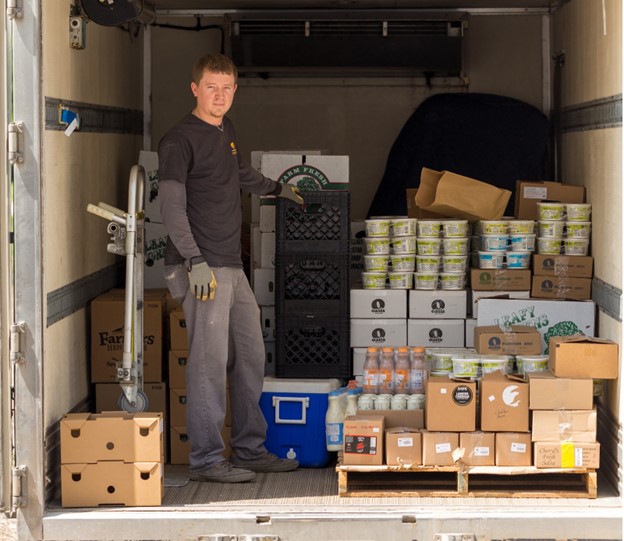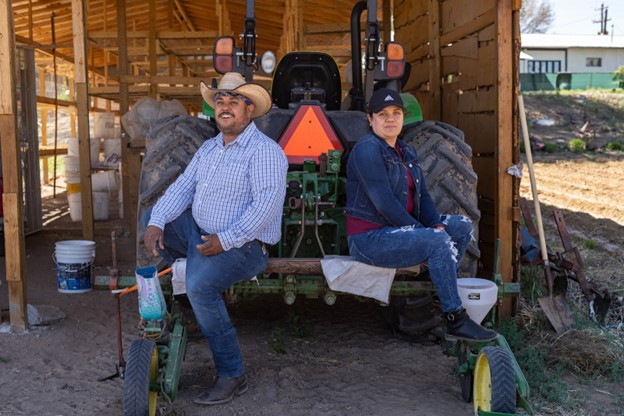
In the short time since its inception in 2021, the US Department of Agriculture’s (USDA) Local Food Purchase Assistance (LFPA) program has demonstrated its capacity to create economic opportunities for producers, scale regional supply chains, and deliver healthy, culturally relevant food to those in need.
The Local Food Purchase Assistance program is one among many initiatives that USDA’s Agricultural Marketing Service (AMS) is leading to build resilient supply chains and promote market access for local and regional farmers, ranchers, and fishers. Specifically, through LFPA, AMS enters into non-competitive cooperative agreements with states, tribal, and territorial governments that in turn purchase locally grown and raised products to distribute in food assistance programs such as food pantries, schools and other organizations that serve food insecure communities. Each state can tailor their program to support the unique needs of growers and communities, and as a result, the program has offered more than a new market opportunity for farmers; it helps farmers maintain and create jobs and expand and invest in their businesses by securing large institutional contracts. Approximately 80% – or $691 million of the $864 million invested through LFPA – allows for direct purchases from local and regional farmers, ranchers, and fishers. Over half of these purchases will be from socially disadvantaged producers.
The Wallace Center at Winrock International, an NSAC member, recently released a report highlighting the results of initial research that evaluates the preliminary impact of USDA’s Local Food Purchase Assistance (LFPA) program in communities nationwide.

Report Background
Over the past three years, the Wallace Center at Winrock International has sought to better understand the impacts of LFPA, among other AMS farm to food assistance programs across the US. Their research included three main components that offered both informal and formal opportunities for data collection across the diverse format of LFPA programs. These elements include:
- A national Farm to Food Assistance Community of Practice with over 350 people and organizations meeting regularly to encourage peer learning and provide technical assistance
- A national survey of over 300 farm-to-food assistance practitioners in partnership with Duke University World Food Policy Center
- In-depth interviews with a variety of LFPA implementers from tribal leaders, government employees, farmers, food hub operators, and policy experts
Because each LFPA program is structured in a way that serves its region’s unique needs, it can be difficult to measure the overall impact of the program. The findings from the Wallace Center’s research: provides a summary of the overarching impact; highlights program designs that offer maximum economic and community benefits; indicates areas where program design could be improved; and makes recommendations to sustain the impact and growth of the program.
Successful Models
The Local Food Purchase Assistance (LFPA) program is a unique program for Agricultural Marketing Service (AMS) Commodity Procurement since the agency enters into non-competitive cooperative agreements with states, tribes, and territories to purchase local food products on behalf of the agency. While most states chose to administer their LFPA agreement through their respective Department of Agriculture or Food, some opted for alternative agencies such as Departments of Social and Health services, Education, or Environmental Management. These Departments then offered subawards to local entities to conduct the outreach, initiate contracts, and provide technical assistance to a diverse group of local farmers and producers.
Depending on the existing state or regional networks and resources, administrators structured their programs differently but many of the successful models identified in the research had one of the following models:
- Local producer networks and value chain coordinators as the lead,
- Food bank or food bank networks as the lead,
- Or a hybrid model of the two.
While food banks and food bank networks offer the historical expertise of aggregating and distributing foods within the states, models that utilize producer networks and value chain coordinators offer a more diverse network of contracts with food hubs, cooperatives, and other local food business and nonprofits. Interviews with partners that utilized these networks highlighted that while these organizations may not have had the infrastructure for immediate statewide scale, they had trusted relationships with farmers that had been developed over decades. These models will spread LFPA investments to a wider network of growers and producers and can often be more responsive to the needs of farmers, particularly underserved farmers, helping them navigate increased sales and scaling their operations.
Across all model types, LFPA has served as a catalyst for new relationships between buyers and growers. As the report highlights, LFPA has offered opportunities for food banks to partner with local food hubs and regional food system networks to purchase locally grown and raised products from farmers and producers they have never previously purchased from.
In many examples, LFPA is paving the way for smaller farmers to access institutional markets. New, larger contracts have incentivized farmers to incorporate additional food safety, processing, and packaging practices to prepare operations for wholesale markets. Participating organizations and local food stakeholders are acting on these farmers’ whole-sale readiness, leveraging their current investment to further build farmer capacity, scale regional value chains, and secure other complimentary institutional contracts, such as schools and universities. As a result, LFPA clearly demonstrates how investing in values-based, local procurement spurs significant growth across the food value chain.
The unique nature of the LFPA program design has the potential to generate sizeable economic returns. The decentralized approach for federal procurement allows for states, territories, and tribal communities to invest in local food systems through food hubs, food banks, and regional farmers creating significant local economic opportunities. LFPA differs from other emergency food purchasing programs as farmers are often negotiating prices directly with their buyers. Wallace Center’s research shows farmers were most often able to secure a wholesale price, or even higher direct-to-consumer prices (41% and 26%, respectively), demonstrating that this program is strengthening local markets across the country.
Barriers to Implementation
The Local Food Purchase Assistance (LFPA) program was funded entirely through one-time investments from the American Rescue Plan Act (ARPA) and the Commodity Credit Corporation (CCC). Each funding source presented unique restrictions on use, including that the majority (or in the case of CCC funds, all) of the award had to be used for the direct purchase of local food products.

While the influx of funding is formidable, these funding restrictions often slowed regions from immediate implementation. For example, in many programs, it was the first time that these institutional buyers were purchasing from small scale, beginning, or underserved growers. Access to land, capital, business technical assistance, and infrastructure continue to be challenges for these growers and while the promise of a purchase contract allowed for these growers to plan accordingly, they often did not have the necessary resources immediately available. Organizations interviewed recognized the need for infrastructure among growers but they also noted that this was short-term funding and they were reluctant to invest in infrastructure not knowing whether funding would be available in the future.
Participating tribal nations were not immune to these challenges, and at times the challenges were exacerbated. Tribal nations experienced additional barriers due to administrative rules that did not consider unique conditions in their communities. For example, AMS utilized the Emergency Food Assistance Program (TEFAP) formula to determine funding levels for states, territories, and tribes, which allocates funding based on poverty and unemployment levels. Funding allocations to tribal nations were determined using the overall state levels where they predominantly reside rather than considering their actual levels within the tribal community, which was often a significantly higher rate. As a result, tribal communities were left notably underfunded, even when they often experienced higher expenses for implementing their programs, such as transportation costs.
Lastly, the program’s payment terms often created tensions between state agencies, organizations, and the contracted farmers. Implementing organizations, such as food hubs or food banks, had to submit expenses for reimbursement while also paying their farmers in a timely manner. This model is not unusual, and often large organizations have enough cash flow to front these costs. However, many states prioritized partnering with smaller, grassroots organizations to reach underserved farmers. Small-scale nonprofits may not have had the staff readily available to provide additional support for implementation and underserved producers often have limited – if any – access to lines of credit. Leaving an organization or farmer waiting 30 days or more for payments only exacerbates already tight operating margins. While some states were able to avoid this problem by providing more funding upfront, this practice was not uniformly applied across all states.
Recommendations for Continued Success
It is imperative that USDA continues to implement LFPA or another decentralized federal food procurement model that offers the opportunity to use federal funds to invest in local farms and food business that strengthen regional supply chains to address acute hunger needs as well as support broader regional food economies.
LFPA has the capacity to generate systemic change in our regional food supply chains; the barriers identified above are surmountable. By incorporating the following recommendations, the program can continue to generate positive short-term benefits in markets and invest in lasting infrastructure to support communities in establishing resilient regional food systems.
- Continue program administration through cooperative agreements with entities
- Continue to prioritize underserved producers, and specifically Black and Indigenous producers and other producers of color
- Invest in deep and diverse partnerships that build intentional and beneficial redundancies
- Coordinate and align other USDA-AMS investments to support infrastructure needs
- Consult with indigenous coalitions to determine more equitable funding allocation formulas
- Allow tribal governments to source from other tribes and Indigenous producers, even if it exceeds the 400-mile radius requirement
- Provide supportive program oversight to ensure implementers can address administrative challenges, such as payment structures, and utilize best practices for reporting and building lasting partnerships that support a variety of producers and businesses
- Allow for a one time no-cost extension
More details on each of these recommendations can be found in the full report.
This report provides timely input on how local and regional food procurement programs have the potential to make a significant, positive impact in our communities. As Congress is currently in the process of reauthorizing the Farm Bill, they should consider the full contents of this report when identifying ways to sustain similar program efforts in the Farm Bill.
At a minimum, Congress should authorize a permanent USDA procurement program where AMS utilizes the non-competitive cooperative agreement model and allows for states, territories and tribes to implement projects with a range of entities, including farmers, distributors, food hubs, nonprofits, and cooperatives. The program must allow for procurement based on values versus lowest cost and prioritize purchases from socially disadvantaged, beginning farmers, and small and mid-sized farms that are then distributed to food insecure communities through a network of nonprofits and other organizations that historically served these communities.
Congress also has the opportunity to support the broader processing, aggregation, distribution, and value-chain coordination needs to support a vibrant and competitive market where small and regional food and farm businesses can thrive. The following marker bills provide a few complementary initiatives that can create and sustain this market:
- Local Farms and Food Act,
- Strengthening Local Processing Act,
- And the Increasing Land Access, Security, and Opportunities Act.
For more details on the impact of the Local Food Purchase Assistance Program, check out the Wallace Center’s report. For more recommendations on how Congress can write a Farm Bill that builds a strong and resilient future, check out NSAC’s 2023 Farm Bill Platform.

